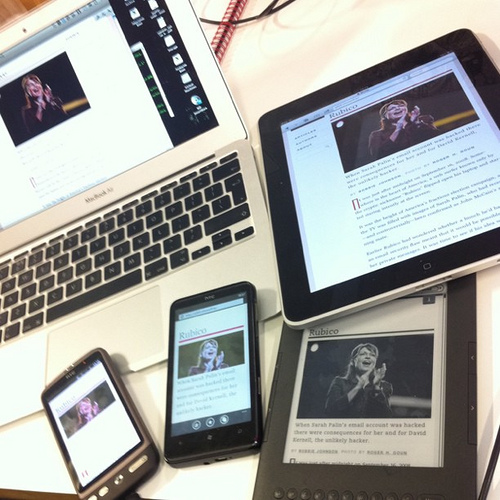Reads of the Week was on vacation last week while I was at digitalNOW in Orlando, which means it’s a long one this week. Again.
In years past, I’ve been envious reading the digitalNOW tweets and watching the keynote webcasts. Since I’m not an association executive, I felt very fortunate to attend this year. Without a doubt, it’s the best association conference I’ve attended. If you’re an association executive, put it on your radar.
To give you a taste, here are a few digitalNOW posts and resources. I’ll share more next week.
- My recent post, Hack Your Association, riffs off one of the sessions I attended, The Maker Society.
- Jay Daughtry’s post, digitalNow 2013 in Less Than 180 Seconds, collects facts and soundbites from the conference.
- Dr. Michio Kaku’s keynote prompted Bill Sheridan to give timely advice to associations and companies: Want to Be Relevant? Be a Wisdom Filter
- If you really want to get inspired, Tom Hood put together TweetDocs for Day 1 (it really is Day 1 despite the file name), Day 2 and Day 3.
Conference season rolls on. Now that the Avectra Users & Developers Conference, ASAE Great Ideas and digitalNOW are behind me, the only one left, for now, is Digital Marketing for Business on Monday and Tuesday at the Raleigh Convention Center. It does not at all surprise me that a conference organized by Phil Buckley is the first result when you google “digital marketing for business.” All hail the SEO master!
If you’re in the nonprofit space, I probably don’t need to tell you about the NTEN conference that started Thursday. You can attend online or follow along on #13ntc until it ends Saturday.
My sources tell me…
Each week I’m revealing one of my many sources for good reads. Denise Graveline’s regular Friday post, The Weekend Read, on her Don’t Get Caught blog is one of my favorites. One of my good reads this week is also from Denise — Tweeting About Food, and Why It’s Smarter Than You Think. She tells you why and when it’s okay to tweet about food. So there!
Let’s talk about it
Chris Bonney at Vanguard Technology shares a list of questions associations should ask about their website. Gather some colleagues, grab some lunch and go over these questions so you can “help your association shake loose from old beliefs about your association website and start thinking about it not as a part of organization, but as your organization itself.”
Now, the reads of the week
I am not a robot. But, I may be replaceable, or at least that was my fear when I read Mitch Joel’s post about a ‘Robo-reporter’ computer program that writes newspaper articles. But then he reassured me:
“The true power in this is not how computers, algorithms and robots can now replace human writers. The true power is in how computers, algorithms and robots can now free up these human writers to do the more important work that our society requires of them.”
Phew.
You can do something a robot can’t do: convince your C-suite that your organization needs to develop and implement a content strategy. And, if you have Hilary Marsh’s presentation in hand, good money says you’ll succeed.
“The algorithm will likely replace the editor and curator.” Algorithms, again! One day, I’ll wonder how I ever got along without them. Roger Wood and Evelyn Robbrecht wrote a fascinating article about Intelligent Content at paidContent. “Written and visual content will eventually be continuously reconfigured and redesigned by the moment to accommodate data gathered about what you like to read.” That’s fine and all, but I don’t want to live in a content bubble. Hopefully I’ll always have the random serendipity of Twitter.
Where I get cranky
Stop using so many damn hashtags! “When kept to a small scale, they can ably perform their service as a filter of relevant tweets” – like my beloved #assnchat. But, Daniel Victor at Nieman Journalism Lab says:
“I believe for every person who stumbles upon your tweet via hashtag, you’re likely turning off many more who are put off by hashtag overuse. We need not banish the hashtag, but let’s start putting more thought into when we’re using it.”
Wise up, tweeps! Nonprofit Tech 2.0 identifies five types of tweets you should never post. Note number 3, please. Seriously, these are all obnoxious.
Quickies
- Cute kitten videos are all that stand between us and the cyber-apocalypse. (The Verge)
- Study says…blogs are still more influential than Twitter. Of course they are. (The Wall)
- Turn your Google Analytics into an infographic with Visual.ly. (SocialTimes)
- Note to self: the next time you’re tempted to use the word awesome… (Instead of Awesome)
- Become a masterful note-taker. (The Atlantic)
- Make sure you’re legally using online photos. (Lifehacker)
- Four questions to ask before you send that press release. (Ragan’s PR Daily)
Read a poem
Thank you, Jeff Cobb, for tweeting the link to this inspiring post, Five Reasons Why We Need Poetry in School. It reminded me that it’s been way too long since I sat with a poem. I’m making a date this weekend for some time on the couch with a poet. Hmm, now who should it be?
Feed your neighbors
There’s a really good reason to visit Facebook every single day, at least until the end of April. Walmart is providing $3 million in grants for hunger relief programs – that’s means 35,000,000 (yes, million) meals — for food banks across the country. You can vote once a day for your local food bank on Walmart’s Facebook page. I’ll be voting, of course, for the Food Bank of Central and Eastern North Carolina.
Happy Friday!









